This homemade deodorant stick is a simple recipe that actually works! Using DIY deodorant is a great way to support your health, reduce waste and chemicals, and smell good!
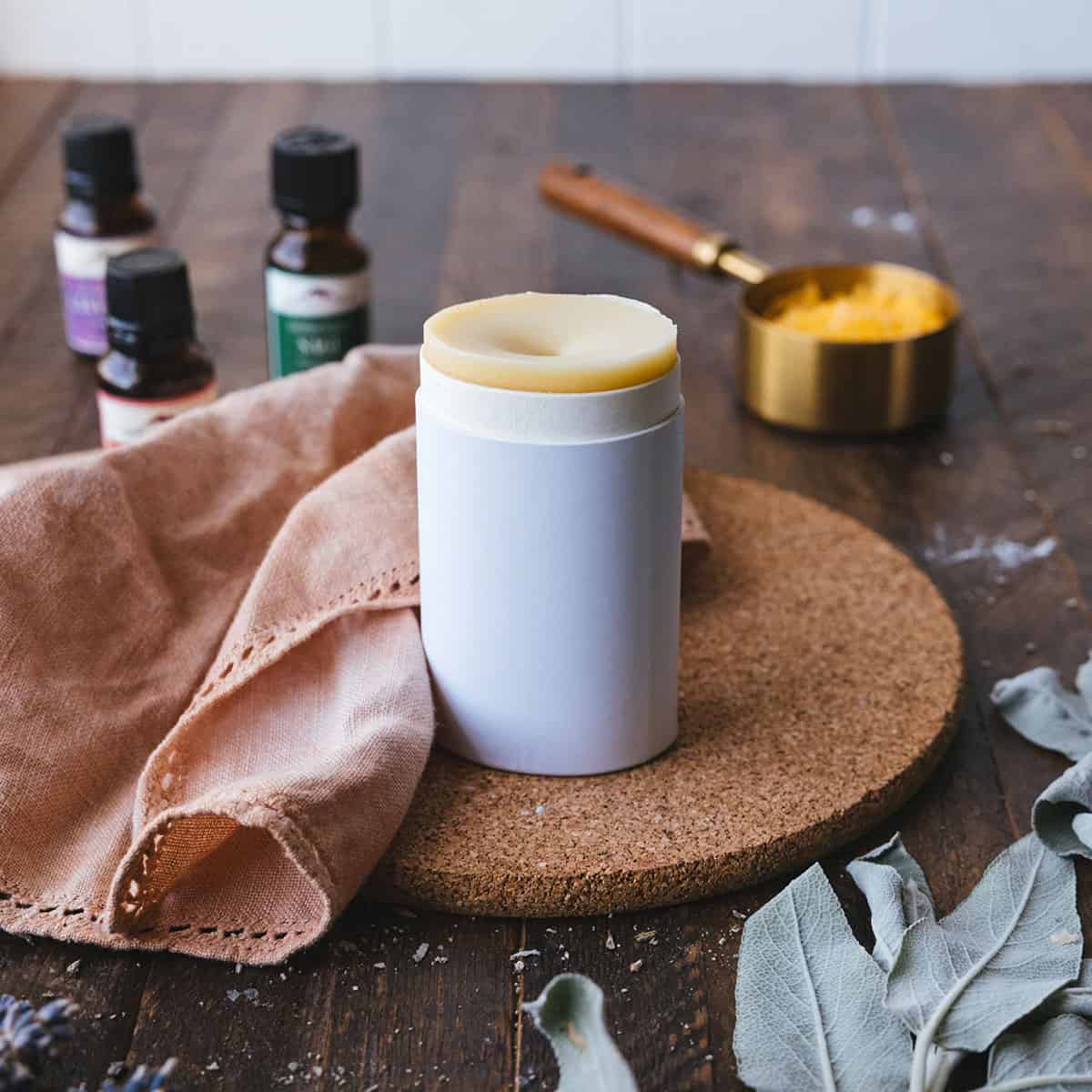
Want to save this post for later?
When I first began delving into making herbal bath and beauty products myself many years ago, it all started with homemade herbal deodorant. It’s the perfect beginner recipe for DIY beauty products.
This recipe is simple to make, is good for your health and the environment. The best part is that this homemade deodorant recipe really works!
Why Make Your Own Deodorant?
You might wonder why you’d want to make your own deodorant when there are so many on the market to choose from. First of all, in my experience, none of the natural deodorants sold in stores work very well and they’re ridiculously expensive.
They might smell good going on, but give it a day’s work, a stressful meeting, or your daily workout, and you might as well not wear deodorant at all. That’s just not my jam!
Then, regular store bought deodorant is full very questionable ingredients, to say the least. If you haven’t looked at the ingredient list, I suggest checking it out. I don’t know what half of it even is!
I know you’re not eating it, but all those chemicals can get into your body through your skin. One of the main benefits of DIY beauty products is that you have control over exactly what is going into it.
Plus, homemade deodorant is so much easier on the environment. It reduces plastic container waste, and any other production waste too.
I prefer to use the cardboard containers shown in the photos, but silicone molds work just as well.
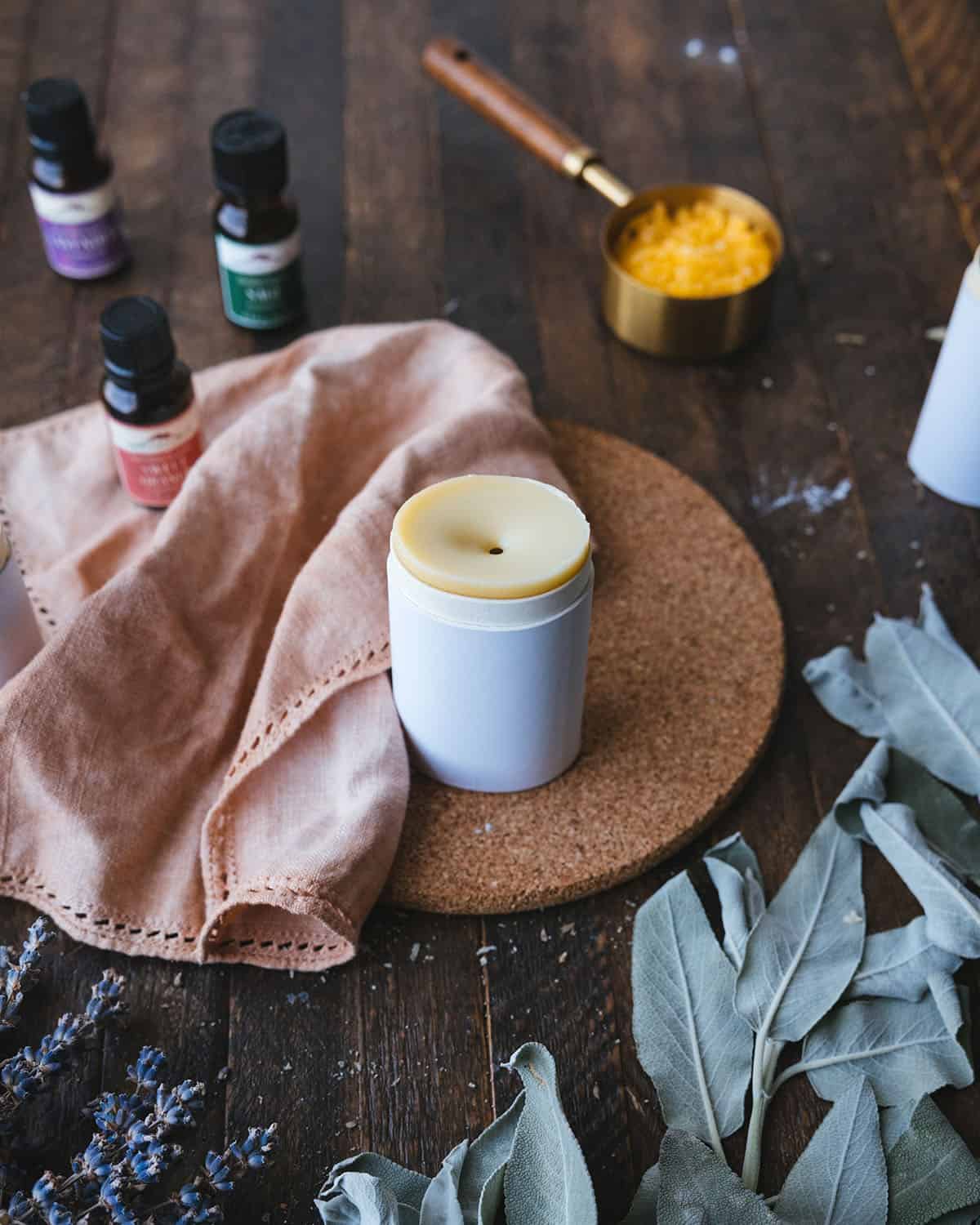
What Goes in Homemade Deodorant?
Homemade deodorant is a common recipe, generally using coconut oil, baking soda, arrowroot or cornstarch, and essential oils. It works well as deodorant, but is too soft for a mold or tube, and melts in warm weather making it unusable.
This is why I created a homemade deodorant recipe that is a little bit different. Using beeswax and shea butter creates a thicker consistency that will hold up in a deodorant container or a mold.
This makes applying it much easier no matter the weather! Plus, you get the benefits of a natural deodorant stick, and your fingers don’t get messy applying it either way.
Ingredients
Beeswax is beneficial in homemade deodorant recipes because it’s naturally antiseptic, antibacterial, emollient, and hydrating to the skin.
Shea butter is odorless (if you used refined), moisturizing, and works to help with a perfect natural deodorant stick consistency.
Substitute: It works to use carnauba wax instead of beeswax, if preferred. Use less than called for, as it’s a harder wax.
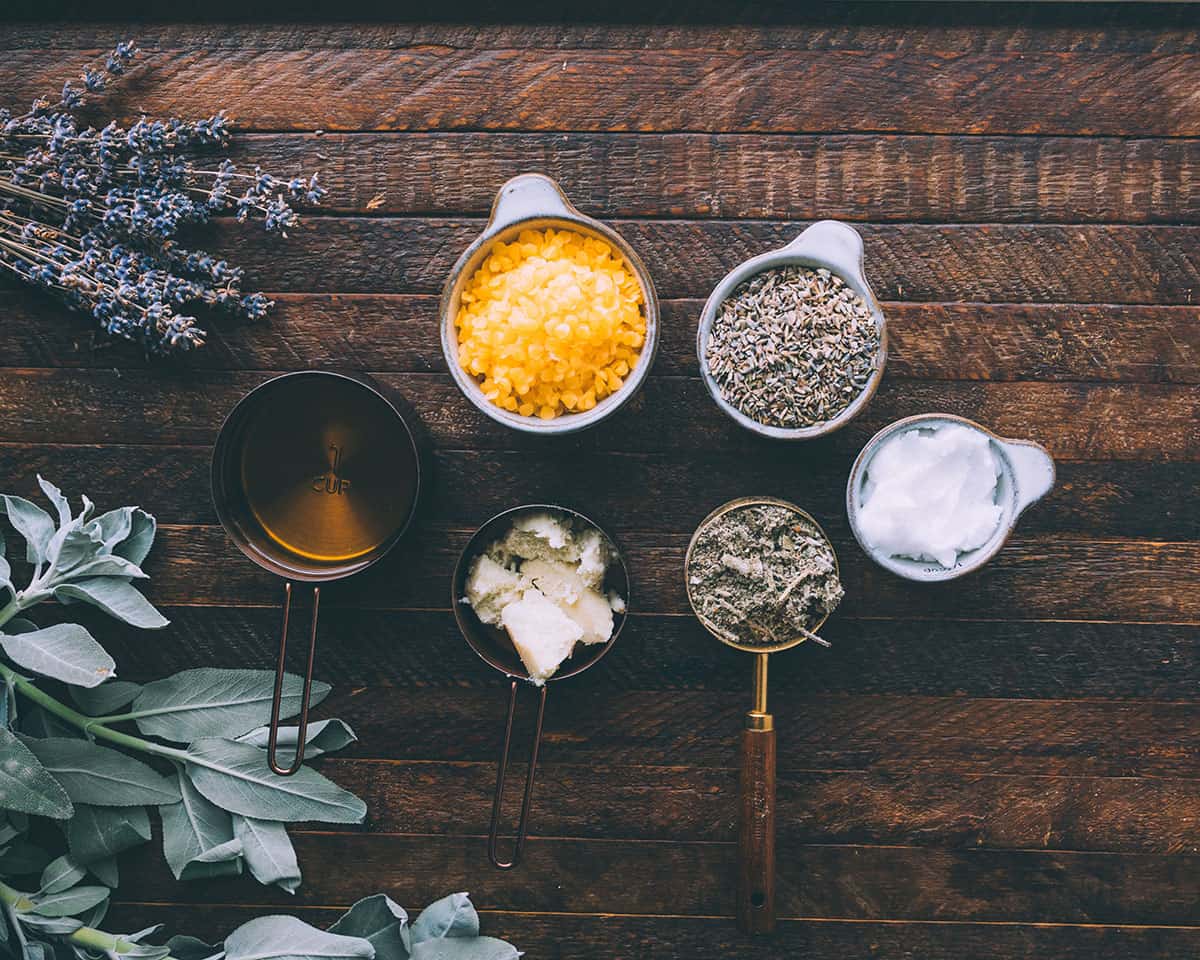
Baking soda and arrowroot powder work perfectly for their natural deodorizing effect. If you are sensitive to baking soda, it’s okay to omit it and replace with more arrowroot powder.
Essential oils make the deodorant smell good while also adding some antimicrobial, antibacterial, and anti-fungal properties.
Infused oil: An herbal infused blend of coconut oil and sweet almond oil works best for this deodorant recipe. Coconut oil is antimicrobial and anti-fungal, and sweet almond oil is light and absorbs easily into the skin, leaving minimal oil residue left after application.
Dried lavender and sage are the best choices for making herbal deodorant.
Note: Lavender is wonderful for skin care products due to germ fighting benefits and its beautifully calming scent. Sage is perfect because it has some natural antiperspirant properties.
There are many other herbs you could choose depending on your preferences. Some good options are rosemary, mint, calendula, oregano, marshmallow root, yarrow, rose, chamomile, and lemon balm.
My favorite place to get high quality, organic dried herbs is Mountain Rose Herbs.
Homemade Deodorant Recipe with Lavender and Sage
The first step in this recipe is to make an infused herbal oil with lavender and sage, or any other herbs of your choice.
For the Infused Herbal Oil
First, place the dried lavender and sage, or other herbs of your choice in a pint mason jar.
Then, melt the coconut oil over low heat. This should only take a few minutes.
Pour the melted coconut oil into the jar over the herbs, and then fill the jar up the rest of the way with sweet almond oil.
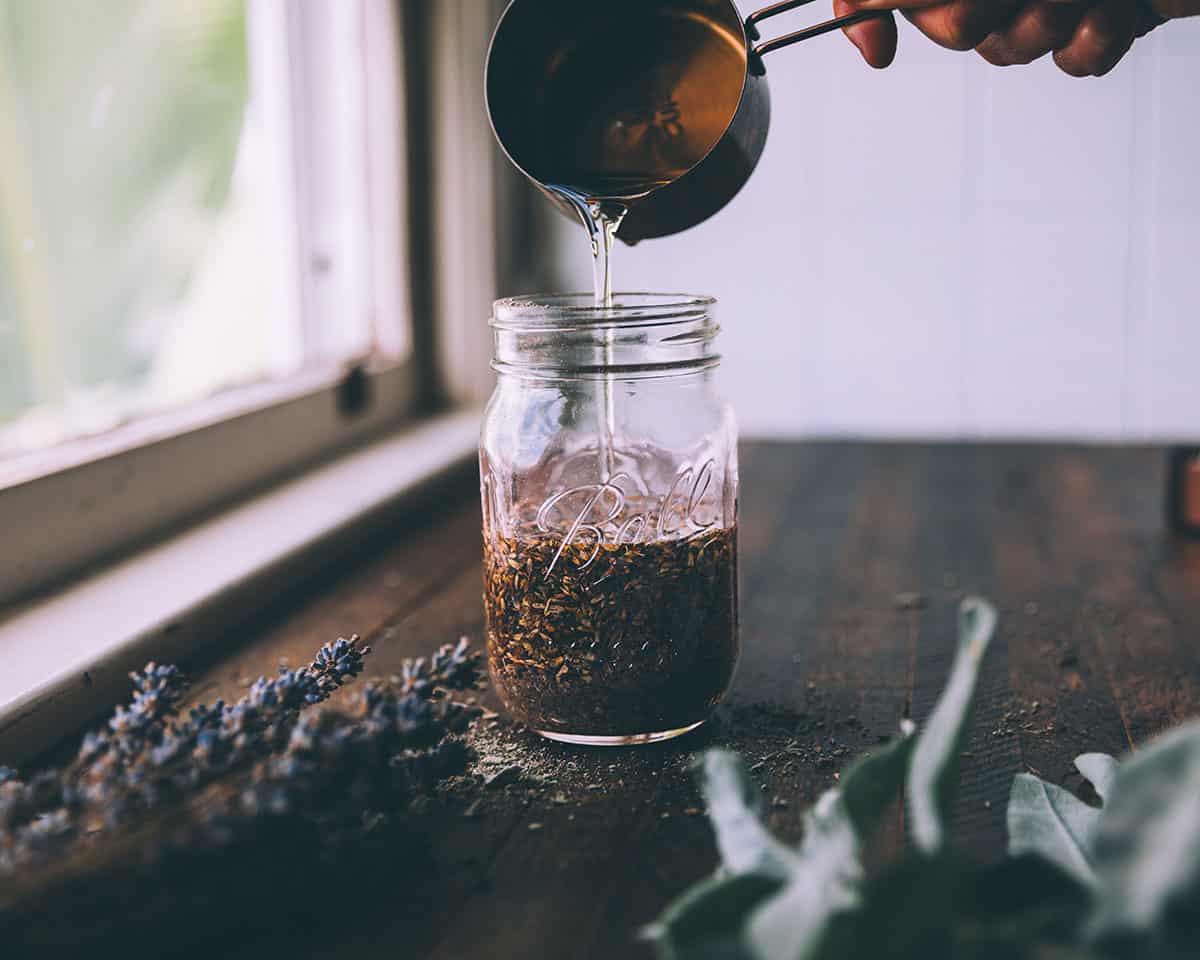
Now, cover the jar and put it in a cool and dark place like a pantry or a kitchen corner without sunlight. Let it infuse for 1-2 weeks.
Once infused, strain the spent herbs out with a fine mesh sieve. Now it is ready to use in homemade deodorant!
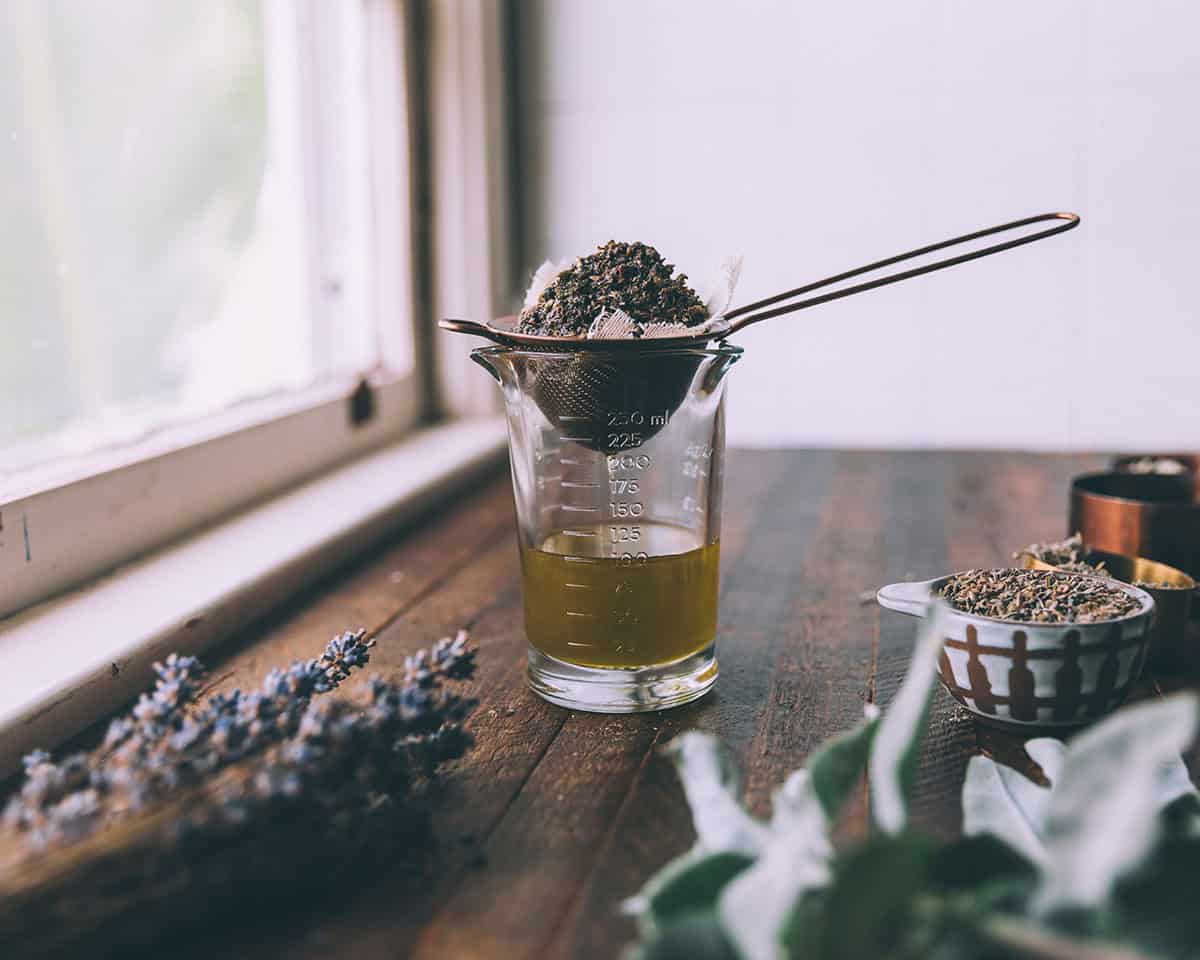
Make the Deodorant
Now that the infused oil is ready, put it and the beeswax into the top container of a double boiler. Stir continuously as the beeswax melts.
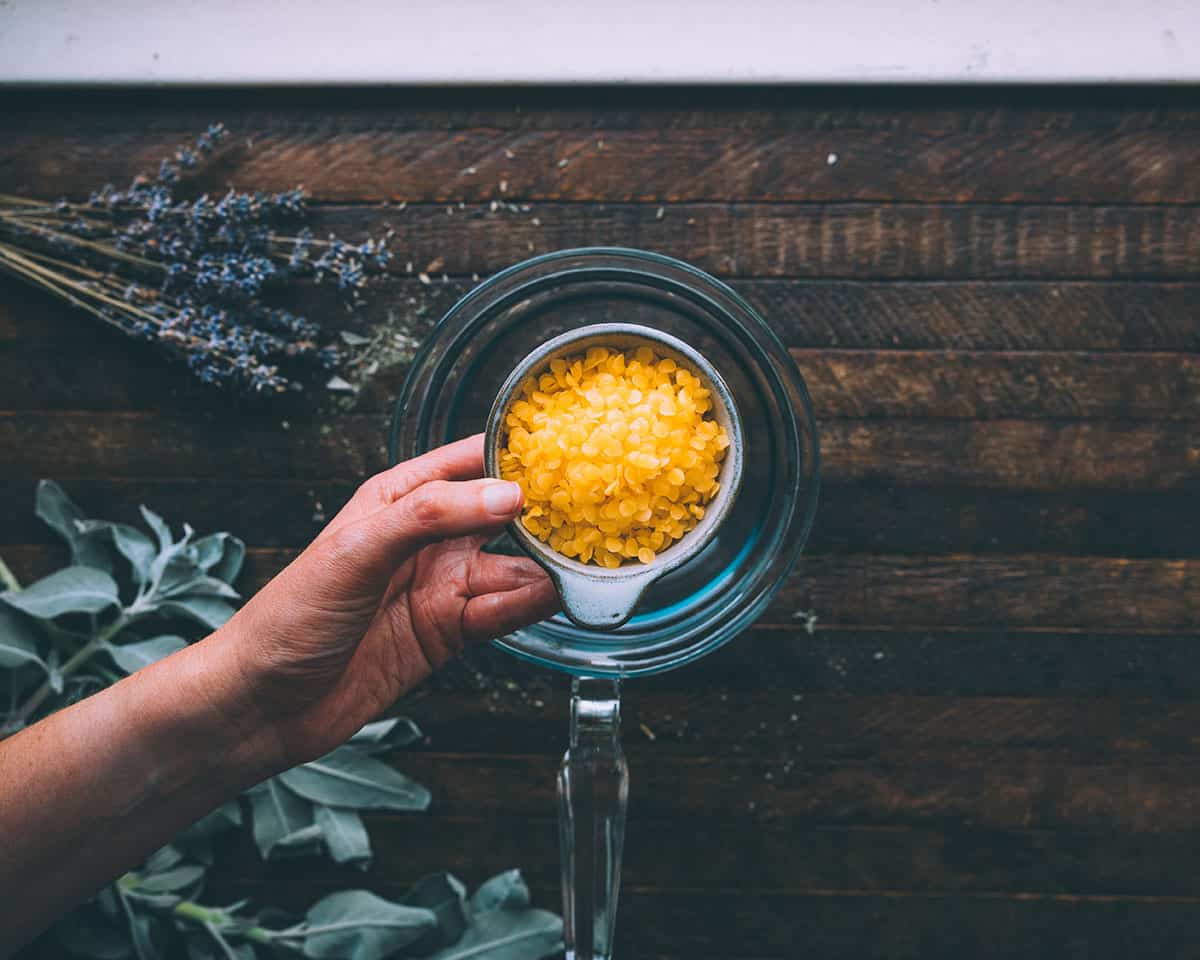
Note: You can use a makeshift double boiler using a smaller pot, bowl, or a glass Pyrex measuring cup over an inch or so of water simmering in a pot.
Once the beeswax has completely melted, add the shea butter and stir until it dissolves.
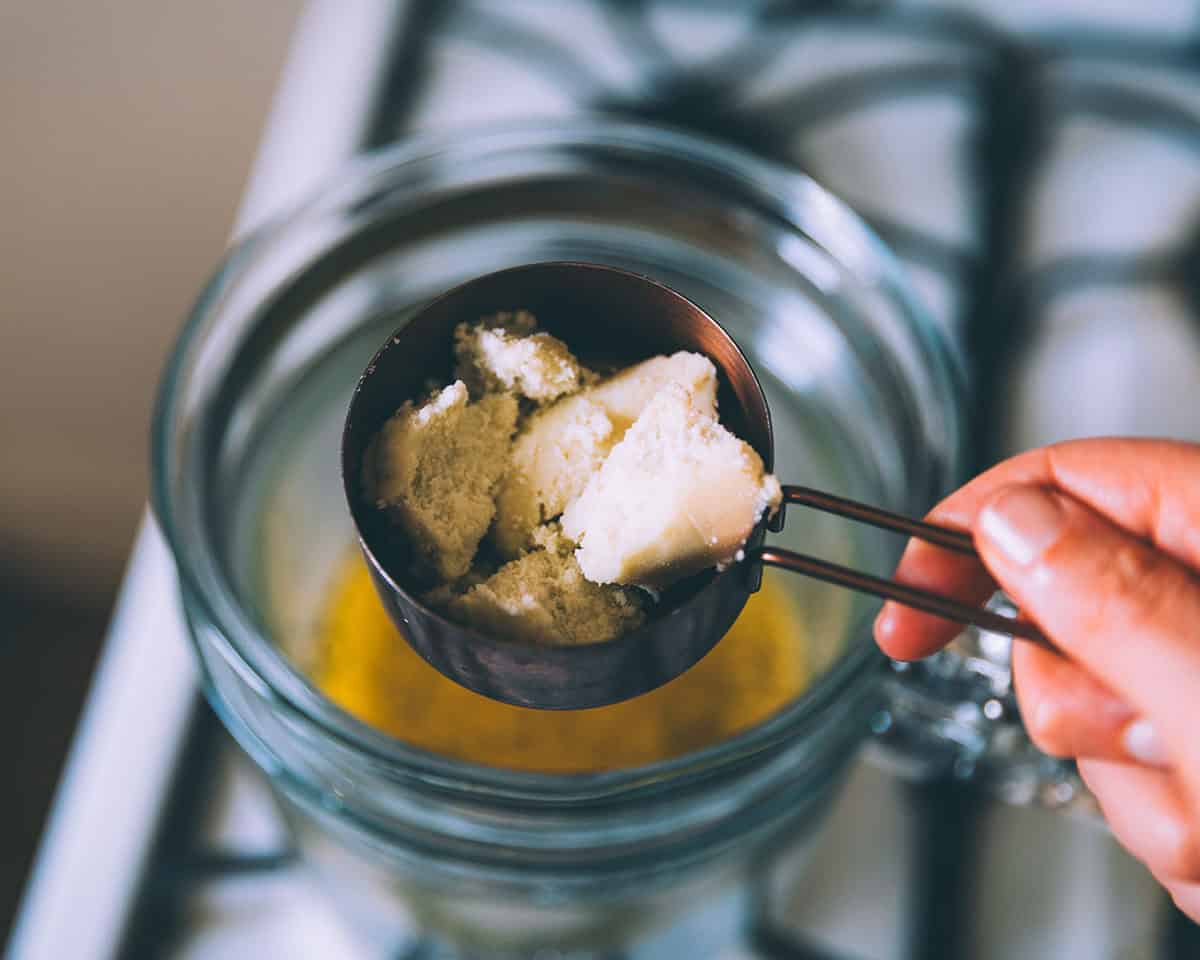
Remove the mixture from the double boiler and stir in the essential oils, then stir in the arrowroot powder and baking soda.
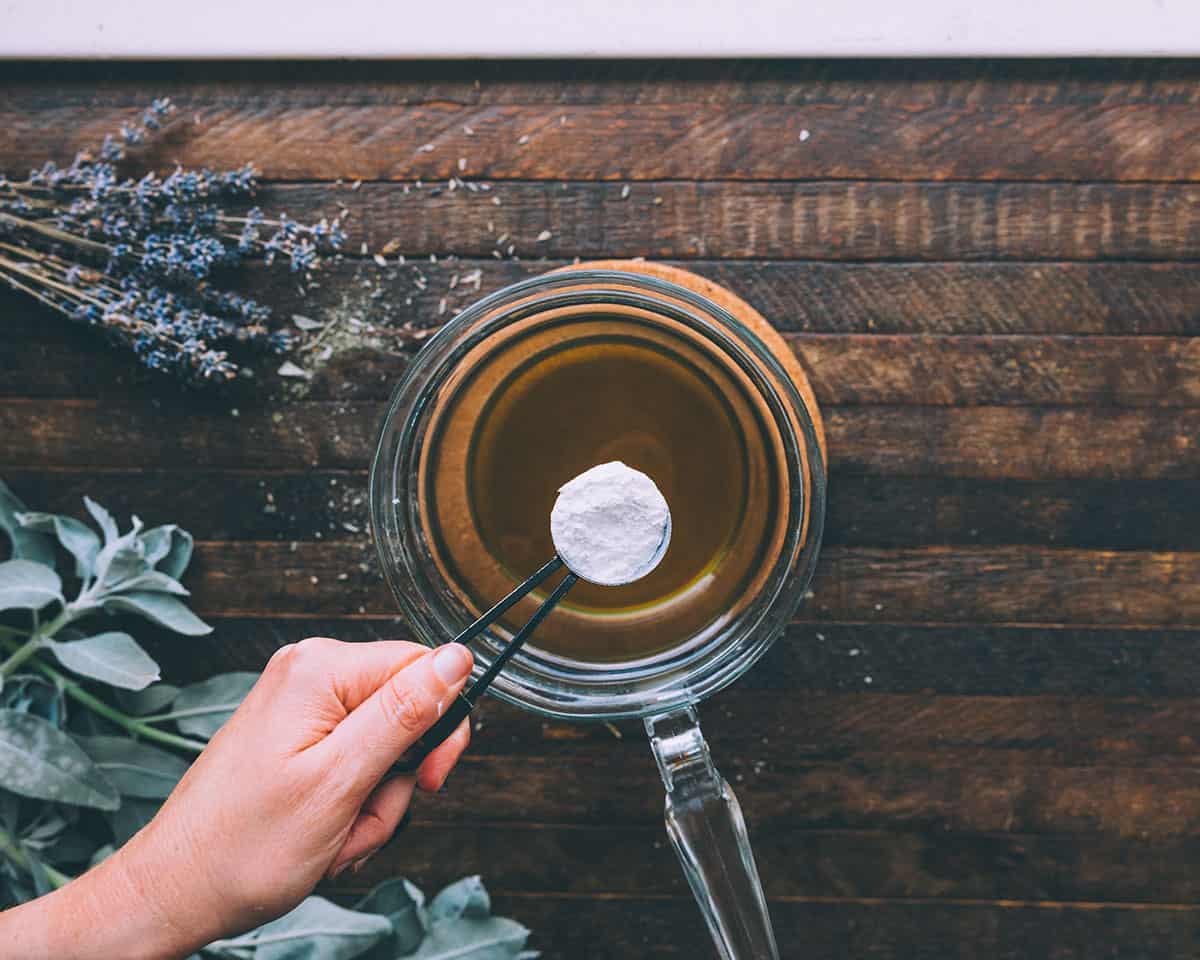
Keep stirring for a minute or two to thoroughly combine. The mixture will begin to thicken slightly.
Pour the mixture into empty deodorant containers or half circle silicone molds.
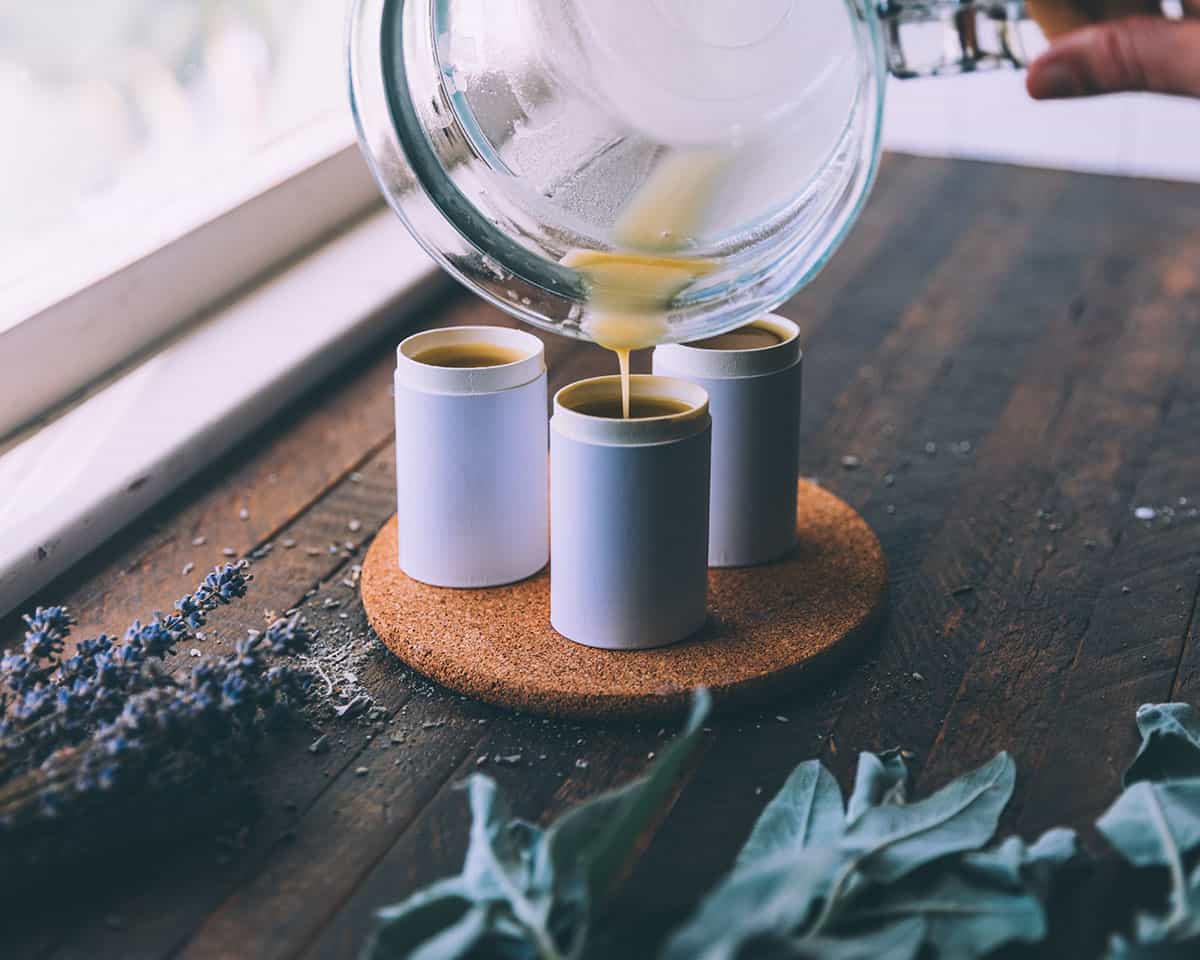
Let the deodorant set up for a few hours until it is solidly formed before using.
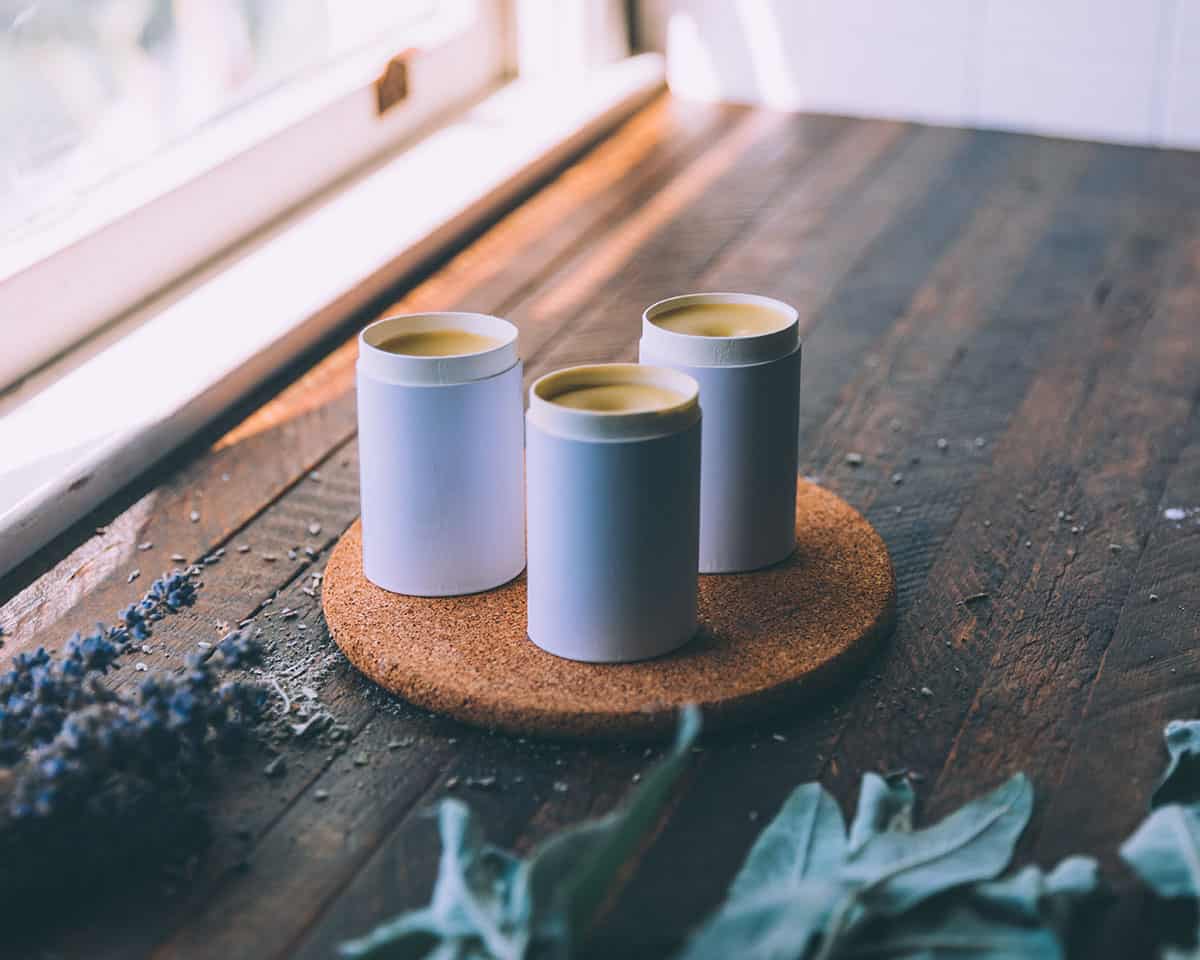
Using Herbal DIY Deodorant
Use your herbal homemade deodorant just as you would any other deodorant, it’s that easy. It’s amazing how well this deodorant works, the lavender and sage combination are highly effective and smell good.
Even if you’ve had trouble with homemade deodorants in the past, I recommend you try this one. It is absolutely the best natural deodorant, and I’m so happy to be ditching the store bought stuff for good!
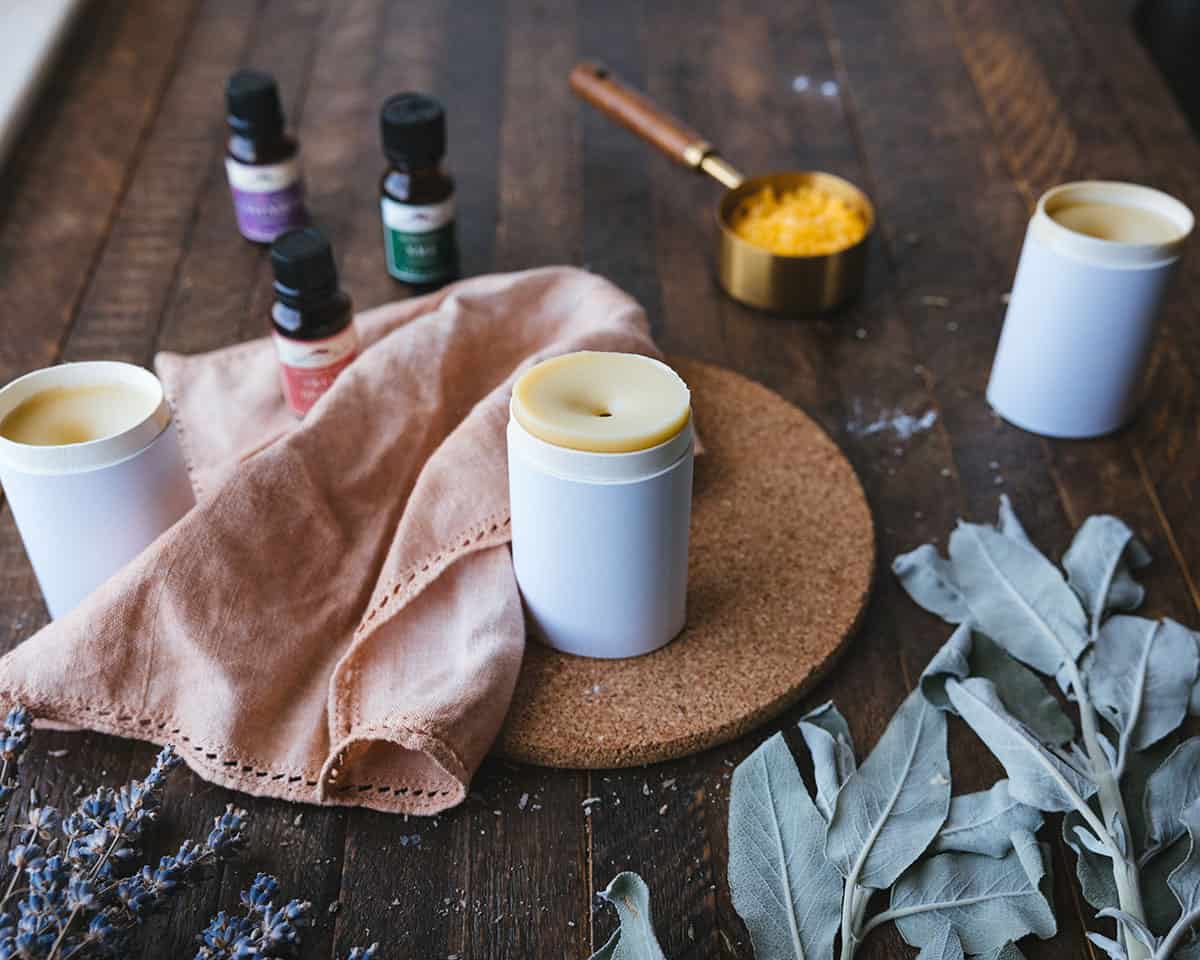
Keep in mind that if you are new to natural deodorant without antiperspirant, many people notice increased sweating as their body adjusts. Don’t worry though, it will balance out over time.
Once you make the switch to this homemade deodorant, you, your budget, and the earth will be healthier for it!
More DIY Body Care
- Lavender Salve
- Calendula Lip Balm
- Rosemary Pine Beard Balm
- Rosemary Mint Shampoo Bars
- Rose Lotion Bars
- Rose Hip Facial Oil
Homemade Deodorant with Sage and Lavender
Equipment
Ingredients
Infused Herbal Oil
- 1/3 cup dried sage leaves
- 1/3 cup dried lavender
- 1/4 cup coconut oil
- 3/4 cup sweet almond oil (approximately)
Homemade Deodorant
- 1/2 cup infused herbal oil
- 2 ounces beeswax
- 1 ounce shea butter
- 20-30 drops essential oil I like to use 10 drops each of lavender, sage, and sweet orange
- 2 tablespoons arrowroot powder
- 2 teaspoons baking soda optional or substitute with more arrowroot powder
Instructions
Infused Herbal Oil
- Place the herbs in a half pint mason jar.
- Melt the coconut oil over low heat.
- Add the coconut oil to the jar of herbs and then fill the jar the rest of the way with sweet almond oil.
- Cover the jar and put in a cool and dark place to infuse for 1-2 weeks.
- Strain out the herbal material with a fine mesh sieve when ready to use.
Homemade Deodorant
- Put the infused oil and beeswax into the top container of a double boiler, and stir as the beeswax melts. You can create a makeshift double boiler by putting a small bowl or a glass Pyrex measuring cup over a pot with about an inch of simmering water.
- Once the beeswax has completely melted, add the shea butter and stir until it dissolves.
- Remove the mixture from the double boiler and stir in the essential oils, then stir in the arrowroot powder and baking soda. Keep stirring for a minute or two to thoroughly combine. The mixture will begin to thicken slightly.
- Pour the mixture into empty deodorant containers. Let the deodorant set up for a few hours before using.
Notes

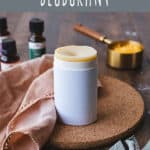

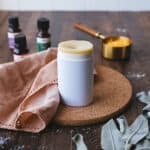

Hi, can’t wait to try this! Could you please tell me what would be better to use white or yellow beeswax? Thanks
I have a question, do I have to fill the whole mason jar with sweet almond oil since it is a lot of herbs I feel or is it enough with the 2/3? Because when I added the 2/3 it seemed to little for me because the herbs sucked the whole sweet almond oil, I’m not sure if it’s supposed to look like there’s a lot of oil or not
any problem with the beeswax clogging pores, the way commercial antiperspirants work?
Hello!
Could clay also be used?
Hey do you think I can replace the coconut oil with grapeseed oil? Coconut oil gets hard!
Also did you use any food colorant?
What good combinations in essential oils and infused oils work well for men? My husband has sensitive skin and all the other homemade recipes were a flop. This recipe seems like a winner.
Unfortunately can’t find arrowroot where i come from. Can i replace it with something else? Thank you.
Cornstarch
Tapioca flour(tapioca starch) can be substituted for arrowroot.and yes cornstarch.
Love this recipe, thank you for posting it. It’s the first deodorant that I have made that actually last all day, doesn’t stain my shirts, or turn my armpits a dark color. This will be my go to recipe from now on!
Hi, did you do the infusion or just add the essential oils? I wonder if this will work as well without doing the infusion
Could you substitute cocoa butter for the shea butter? My skin doesn’t seem to like shea butter.
Yes Cocoa butter can be used.
What about its shelf life?
I have tried making your dandelion salve several times, with great success! I’m interested in trying this recipe too. But how long does the deodorant work? Do you have to reapply during the day?
I have two 1/2 rounds used for making bath balms.. could I use these for the deodorant molds, if so, should I grease them 1st? thanks,
Hi Bonnie, yes those would probably work. I don’t usually grease them as the deodorants come out easily, but you could try it just to be sure!
Hey, this recipe sounds amazing and I am super excited to try it. I do have a question though, do you use a certain type or kind of Shea butter? Such as refined or unrefined? Thank you!
I prefer organic refined as it doesn’t impart any scent.
Great idea as my long-time favorite store-bought deodorant is suddenly unavailable. I’ve always used unscented as I don’t want to broadcast scent, and I’m wondering how much I could cut back on the essential oils without losing anti-microbial effectiveness. Or, is this actually an issue — other people being able to smell it. Thanks!
You can definitely cut down or even leave out the essential oils if you’d like. The lavender and sage in the infused oil will give it a lot of antimicrobial and antiperspirant properties on their own!
I went ahead and made it according to instructions. It smells wonderful and doesn’t “broadcast” at all. Best of it, it works!!!
Collen,
Thank you for this great post. I never cease to be amazed at the wonderful things I can do with my beeswax.
This sounds so easy! Please share what containers you’ve found to stir the finished deodorant in. I’m thinking of gifting them! Thank you!
They make great gifts! They are the 4oz tins from Mountain Rose Herbs.
This recipe sounds lovely. I’ve been using simple aloe for about a year now. I discovered by accident that it works as a deodorant. I had an inflamed pore in one of my armpits so stopped using regular deodorant and rubbed on aloe after my showers in an attempt to calm the red and sore blocked pore. After a few days I realized that the aloe inhibits odor. I tried going without it but that will never work for me. Having something that smells nice under my arms would be nice though so may try your recipe. What if you just add more essential oil instead of infusing with dry herbs?
You could try that, but I’m always a fan of using whole herbs whenever possible!
I cannot wait to try this. Been looking for a good recipe. Thank you so much for posting.
Hi i can not use coconut oil or almond oil due to allergies has anyone made this with other oils? Like grape seed or olive oil? Thanks
Any carrier oil that you prefer will work!
I have developed an allergy to sage (what the heck!) have you tried any other herb with the lavendar? Rosemary maybe? Or Basal? I could maybe use an oil if I am not growing the herb?
Instead of baking soda try food grade diatinatious earth, you wont have to reapply so often. Also activated charcoal is an option too. :)
Food grade Diatomaceous Earth can be an irritant as it is very sharp and cuts my fingers when I apply it barehanded on my cat for flea control. Thank you for this recipe!
Adding more beeswax should fix both issues!
Hello. Great ideas here very inspired to do this. I was wondering with the half rounds how you apply? Do you take them out and apply like a bar of soap in hand? Could be a stupid question. Thanks in advance.
Same question from me too :)
Yes, to apply using the half rounds simply take it out of the tin and rub the rounded side on your pits. It’s as simple as that :)
Many thanks Colleen! Will certainly try this one…
Hi, I’ve been making my own deodorant for some time now with a very similar recipe. To make it harder in a warmer climate I exchange some of the coconut oil with cocoa butter – it smells heavenly and keeps the deodorant pretty solid even when it gets warmer.
I am seriously thinking of doing this but does it stain or leave a residue on your shirts? Does it wash out well? Thanks alot in advance.
T
I have never had a problem with it staining my clothes. Try it, I think you’ll like it :)
Thanks alot. I will.
That’s definitely the case for me with the non-beeswax version, but I feel like the beeswax one works much better and lasts longer. Maybe add more drops of essential oils? I love Wild Orange oil, sometimes when I don’t have the homemade deodorant made I just rub the Orange oil in my pits and it’s wonderful!
You know, your sister’s technique is just not to sweat….ever…! :)
Ha! Yeah, how does she get away with that???
cool!
How bout some honey? A natural antimicrobial, antifungal etc…
That’s what the beeswax is for… honey might be a little too sticky!
amazing! I did not know you could do this!
I know, it’s pretty cool, huh? Glad you like it!